Divinities and ancestors belong to the group of venerable beings. The Òrìṣà and the divinities take their shape through the expressions of nature. They are the creators of the divine and define the affiliation between the humans and the universe. This is why they represent virtues and powers of the universe while also managing the relationships within the system in its entirety.
The ancestors are inextricably linked to the social order. One could say that ancestors are the creators of people who determine the affiliation of individuals with certain social structures. They represent virtues and powers of certain families and lineages, and within these groups, they determine and manage social relationships, ethics, and moral discipline.
The primordial divinities include the Òrìṣà Ọbàtálá, also called Òrìṣànlá or Òṣálá, the one who created the physical appearance of humans, the Òrìṣà Ọ̀rúnmìlà, also called Ifá, the Òrìṣà Èṣù, and the Òrìṣà Ògún.
The Òrìṣà are referred to by different names, including imalẹ̀, which is most likely a shortened version of the term ẹmọ́-ti-mbẹ-n’ílẹ̀ that means “superior beings on Earth”. Every Òrìṣà possesses its own attributes, qualities, and characteristics. Let us take a look at the basic characteristics and symbols of certain Òrìṣà who, together with Èṣù, constitute the Yoruba pantheon. And just how many Òrìṣà constitute the Yoruba pantheon? Some oral sources say 201, while others say there are 401, 600, 1,060, 1,440, or even 1,700 Òrìṣà. It is known that some divinities are honoured throughout the entire Yorubaland whilst others enjoy their special importance only within the borders of certain regions.
Order comes from chaos, and justice is often reached by fighting injustice. The Òrìṣà Èṣù, the owner of basic principles of peace and harmony, creates and manages order, discipline, and organization as opposed to disharmony, disorder, and confusion. Èṣù promotes discipline and demands order and organization while also being the source of courage and power to which we turn to. The devotees of Òrìṣà perceive Èṣù as the most powerful one because he is omnipresent in each and every life situation. He is the middle man between the people and the Òrìṣà as well as between the Òrìṣà themselves because without his Àṣé, there is no success in life. Thus, even the Àṣé of all other Òrìṣà cannot be utilized without the Àṣé of Èṣù.
Beside the fact that he controls and manages the Àṣé of all the Òrìṣà, Èṣù is present in peoples’ everyday lives. He is the one people find additional strength in. Èṣù is mighty, powerful, benevolent, magnanimous, and fearsome. Mighty because he is present in everything and everyone and because he brings to his devotees the Àṣé that makes them invincible; benevolent because he leads humans to success and wealth and protects them from injustice; magnanimous because he shares all his capabilities with humans; fearsome because he can join all the existing forces and has the power to realize anything he wants whenever he wants.
Patience is a virtue that must be adopted by every devotee of Èṣù.
The Òrìṣà Ọ̀rúnmìlà, also referred to as Ọ̀rúnmìlà-Ifá or Ifá, is the Yoruba prophetic divinity that is highly respected and held in the greatest regard due to his immense wisdom. The expression Ọ̀rúnmìlà refers to the divinity whilst the word Ifá simultaneously denotes both the divinity and the divination system.
The main symbols of the Òrìṣà Ọ̀rúnmìlà are ikin (palm tree seeds), óta (an altar stone), ìbò (an accessory used by Ọ̀rúnmìlà’s priests or priestesses to either confirm the question asked when consulting the divination or to consult and receive a yes or no answer), ìrùkẹ̀rẹ̀ (an animal tail with artistic decoration that is infused with magic and worn by priests and priestesses, kings and queens as a sign of their royal dignity), ọ̀pẹ̀lẹ̀ (a divinatory necklace), ọpọ́n Ifá (a divinatory plate), cowries, and carved ivory items that are saved in a pot and placed a bit higher in a corner or in the middle of a room. Ọ̀rúnmìlà’s necklaces and bracelets are made of interchanging beads in green and brown.
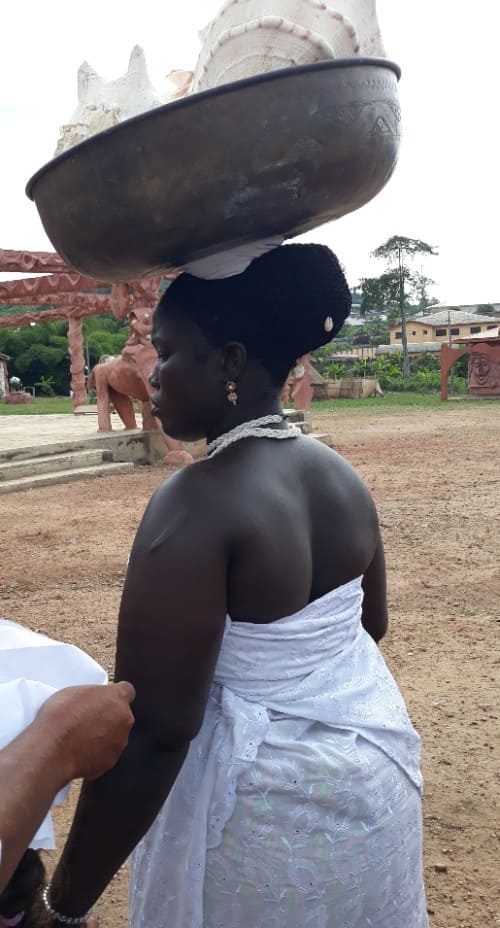
Ajé is the Òrìṣà of progress, prosperity, abundance, well-being, the recognition of efforts, and economic affluence. She promotes wise and prudent use of money and good luck. She protects her devotees against jealousy and other energies that might compromise their economic advancement. For example, she provides protection against energies that are connected to money and result from payments made in anger or in a bad mood. At the same time the Òrìṣà Ajé possesses the power to make people’s actions visible and recognizable. This is why she is being worshiped by the Òrìṣà themselves as well. As the personification of money and success she must constantly confront other Òrìṣà in order to retain her power that each and every other Òrìṣà wants to possess.
The Òrìṣà Ajé is connected to all precious metals. Her symbols are óta (an altar stone), ìrùkẹ̀rẹ̀ (an artistically processed animal tail that is infused with magic and worn by priests and priestesses, kings and queens to showcase their royal dignity), ajé (seashells), cowries, starfish, calabashes, and cotton. The colour associated with the Òrìṣà Ajé is white. Her necklaces and bracelets are embellished with small shells and cowries.
About Àbíkú
Events like abortions or premature deaths of children, young people, and adults may be explained as a consequence of the Àbíkú energy called emèré. The term refers to the spirits that belong to ẹgbẹ́ Abíkú (the Àbíkú society).
The expression Àbíkú is composed of a, bí, and kú (born for premature death) or of a, bí, ó, kú (he was given birth and he died). It refers to children or juveniles who die before reaching adulthood, grown-ups who perish before their parents, and grown-ups who die before they manage to conclude their existential cycle. There are two types of Àbíkú: Àbíkú-ọmọdérefers to those who die during their childhood, while Àbíkú-àgbà refers to those who die as juveniles or grown-ups. It is believed that those who belong to Àbíkú make a pact with ẹgbẹ́ Àbíkú that is referred to as ójó orí; this pact stipulates that they will return to ọ̀run once they reach a certain age.
When a woman repeatedly suffers a miscarriage or the loss of a young child, it is understood that Àbíkú-ọmọdé is at work. In such cases, the sequence of losing children can only be interrupted if all necessary actions are taken in order to cut the bond between these spiritual beings and the society they belong to in ọ̀run.
Those who belong to Àbíkú-àgbà concluded a pact with their spiritual community in ọ̀run, and it is believed that this pact determines their return to ọ̀run at a very meaningful and important time of their lives, for instance when they achieve success, before graduation, upon marriage or the birth of a desired child, or just before achieving a great social success.
The Àbíkú can also be manifested as stubbornness, dogged persistence, or self-destructiveness that leads to drug addiction, alcoholism, depression, or interest in activities with high exposure to risk that frequently result in misfortune. Those who are characterized as Àbíkú are usually highly intuitive and blessed with the sensitivity to occurrences involving the spiritual world.
About Ẹgbẹ́
The Àbíkú brotherhood in ọ̀run belongs to the spiritual society referred to as Ẹgbẹ́ (the term is literally translated as “society”). It is constituted of ẹgbẹ́ ayé, the society in the visible world, and ẹgbẹ́ ọ̀run, the society of friends in the invisible world or spiritual friends. These two worlds are so tightly interconnected that they constantly influence each other. This is why it is believed that in order for a human being to be able to happily live in ayé, it is necessary that he or she lives in harmony with his or her spiritual friends in ọ̀run.
The basic solution to the Àbíkú problem is to retract the promise they made to this society. This actually means that a certain Àbíkú individual must become totally unwanted within the group he or she belongs to, and this is achieved by ensuring their comrades in ọ̀run no longer want this person to return into the spiritual world on the predicted date. The purpose of worshiping and making offerings dedicated to ẹgbẹ́ Àbíkú is to keep the Àbíkú individual in ayé by making the members of his society lose interest in him or her. At the same time, Aráagbó or Èré igbó is being worshiped in order to protect him or her from joining the colleagues in the invisible world. If the urge to preserve the balance between ayé and ọ̀run arises, Ẹgbẹ́ works in tandem with Èṣù.
Òrìṣà Ẹgbẹ́ Aráagbó
Ẹgbẹ́, which literally translates as “society”, is the name for the society of friendly spirits or spiritual friends. The name also refers to the Òrìṣà and the society of spiritual beings that live in ọ̀run, in a world that is parallel to the physical one. The Yoruba recognize the existence of two parallel societies that evolve simultaneously – one ẹgbẹ́ in ọ̀run and another one in ayé. It needs to be emphasized that these two societies strongly influence each other. On the basis of this knowledge, it is easier to understand all the events that occur in human lives. Everything that happens in the field of human relationships and each and every achievement on the level of ẹgbẹ́ ayé has its counterpart on the level of ẹgbẹ́ọ̀run.
Èré igbó or Aráagbó literally translates as “the inhabitant of the forest” or “the inhabitant beyond”. In accordance with everything that has been explained so far, this Òrìṣà protects from premature death and alleviates material as well as spiritual suffering of its devotees. It directs all the Orí of Àbíkú and other devotees in a way that creates conditions success. It reigns over resources that speed up healing and contribute to wellbeing, interferes in human destiny by removing all obstacles from people’s lives, brings economic prosperity and stimulates spiritual growth, harmonizes material life with spirituality, improves fertility, and evokes the feeling of peace, tranquillity, stillness, and trust. Ẹgbẹ́turns tears into laughter.
Among the symbols of Ẹgbẹ́ are óta (an altar stone), ìrùkẹ̀rẹ̀ (an animal tail with artistic decoration that is infused with magic and is worn by priests and priestesses, kings and queens as a sign of their royal dignity), yangí (a volcanic stone, laterite, the symbol of Èṣù), àtòrì (a sacred stick), cowries, ìrókò (the sacred tree), a banana palm tree, akòkò (a sacred tree with leaves used during royal initiations and several rituals in the cult of Òrìṣà), pèrègún (the tree of life, a sacred plant with a great vital power), yèyé (a sort of plum tree, a sacred tree). Ẹgbẹ́ loves multi-coloured clothing and necklaces. Its bracelets are made of pearls in various colours in combination with cowries.
An important relationship exists between Ẹgbẹ́ and Ìbéji, the Òrìṣà that is generally connected to nature, especially the forest, where Aráagbó resides. The worship of the Òrìṣà Ìbéji demands worshiping Ẹgbẹ́ as well.

The Òrìṣà Erinlẹ̀ establishes a strong relationship with Ìyá-mi Òṣòròngà and thanks to their combined powers, she functions as the female Òrìṣà of hunting, medicine, magic, and wisdom. She is one of the very first pupils Ògún taught about the art of hunting and war. Thus, she is regarded as the female patron of hunters. Furthermore, she is the Òrìṣà of fertility possessing striking intuition and perception along with great strategic skills. She protects the humiliated and those who experience injustice. She is being worshiped with the purpose of attracting agility and swiftness. She brings good luck in business and in every other sphere related to money while also presiding over family affairs. She highly values life outdoors and adores the forest; she is familiar with all the characteristics of beings who live there. She is being worshiped in tandem with the Òrìṣà Ọ̀sányìn.
Her symbols are óta (an altar stone), ìrùkẹ̀rẹ̀ (an animal tail with artistic decoration that is infused with magic and worn by priests and priestesses, kings and queens as a sign of their royal dignity), ẹ̀jùwẹ̀rẹ̀ (a ritualistic instrument made of leather resembling ìrùkẹ̀rẹ̀ that is also embellished with cowries and pearls), cowries, ọ̀pa (a forged metal stick with sixteen birds), ṣẹ̀kẹrẹ (a kind of a rattle), and àdó (a small hollowed and dried calabash for storing the powder that is used for healing and magical purposes).
The metal that belongs to her is iron. She typically wears multi-coloured clothing, golden bracelets or bracelets decorated with cowries or leather details, and necklaces embellished with cowries and leather details.

The Òrìṣà Èṣùmàrè is a wise man related to aestheticism and self-defence. He supports the communication between ọ̀runand ayé, facilitates communication among people and contacts between humans and nature. He is sympathetic to transformations because he gives magical powers to his initiates.
Metals that belong to him are iron and brass. His basic symbols are snakes forged out of various materials, but also wooden statues that represent a human figure with one or more snakes coiled around it. Other symbols are cowries, calabashes, obì and orógbó nuts, ẹfun (blessed natural calks that possesses great powers), osùn (a type of red pigment used for ritualistic purposes), óta (an altar stone), and ìrùkẹ̀rẹ̀ (artistically processed animal tail that is infused with magic and worn by priests and priestesses, kings and queens to showcase their royal dignity). His colours are green and yellow.
The Òrìṣà Ewa or Yewa, the Mother who will live forever, the everlasting mother, is the Òrìṣà related to Ìyá-mi Òṣòròngà. She is a warrior associated with fire and the possessor of magical powers used for healing and transformation. She can be both motherly and patronizing. Being keenly aware of human suffering, she always strives to transform pain into joy. Blessed with creativity and the sense of aesthetics, she highly values handcrafting skills.
Her symbols are óta (an altar stone), ìrùkẹ̀rẹ̀ (an artistically processed animal tail infused with magic that is worn by priests and priestesses, kings and queens to showcase their royal dignity), osùn (a type of red pigment used for ritualistic purposes), ikódíde (a red feather from the bird called odidẹrẹ́), and cowries. Multi-coloured clothing is her favourite. Her necklaces are embellished with green, yellow, and brown beads.
The name of the Òrìṣà Ìbéji is composed of the term ìbí, which means “to give birth”, and the term eji, which means “two”; the name itself is translated as “to give birth to two” or “double pregnancy” and refers to the birth of twins. Ìbéjiprotects from premature death, alleviates material and spiritual suffering of its devotees, orients the Orí of Àbíkúindividuals in a way that enables them to tread their own paths, brings economic prosperity, stimulates spiritual growth, harmonizes material and spiritual aspects of existence, evokes the feeling of calmness, tranquillity, stillness, and trust, improves fertility, and turns tears into laughter. Ìbéji is related to various forms of duality and is concerned with questions such as to be or not to be, to do or not to do.
The Òrìṣà Ìbéji is always manifested as a duality through its own symbolism and through twin children.
The symbols of Ìbéji are statues carved out of the wood of the ìrókò tree – a figure of a male and a female representing twins, cowries, the ìrókò tree (ìrókò, the sacred tree) and its wood. Twin children are the physical manifestation of Ìbéji,and as such they are regarded as sacred and venerable.
Ìrókò is Olúwéré, the master of secrets and speed. This Òrìṣà is symbolically represented by the African sacred tree with the same name as well as by forests, parks, and gardens. His symbols are space, time, Earth, óta (an altar stone), ìrùkẹ̀rẹ̀(an animal tail with artistic decoration that is infused with magic and worn by priests and priestesses, kings and queens as a sign of their royal dignity), and cowries. Ìrókò is dressed in white while his necklaces are multi-coloured.
He is being worshiped in order to facilitate healing, to ensure the conservation of peace, social harmony and tranquillity, to improve fertility, and to garner the spiritual power that attracts and preserves the Àṣẹ. Because the Òrìṣà Ìrókò stimulates the growth of Orí, it consequently alleviates the state of mental restlessness and encourages personal strength and stability, thus helping people become stronger and capable of facing challenges. The worship of Ìrókò is an expression of gratitude towards nature for everything it offers to humans.

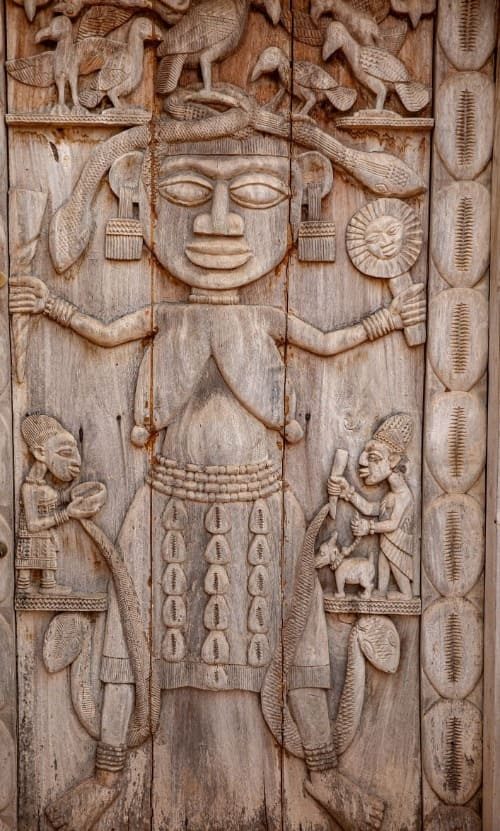
Female ancestral/parental help
Ìyá-mi Òṣòròngà represent the collective aspect of female ancestral powers.
They are the keepers of destinies and are constantly striving to preserve the existence; this is why one needs to cultivate their benevolence in order to secure the survival of life and society.
Ìyá-mi Òṣòròngà appear in many shapes.
They are healers who possess enormous magical powers.
They intervene in peoples’ lives on the personal level – in terms of physical and mental health, partnerships, sexual life – as well as on the social level – with regards to work and friendships.
They provide protection against diseases with the emphasis on internal organs and blood health.
They offer support to human beings with regards to the tasks related to the harmonization of thoughts and knowledge aimed at ensuring successful achievement of goals.
They attract good luck into life and stimulate business activities as well as material achievements.
They bring about changes on the emotional level; under their influence, a restless person is able to calm down, an ill-tempered one gains patience, etc.
They interfere in human destinies with the intention to protect the affected one from harm that is a result of an enemy’s actions or their own mistakes. With their inclination towards marriage, they harmonize interpersonal relationships.
They are the carriers of Àṣẹ and they strive to acquire and retain vital energy.
They serve as protectors and guardians; they direct people and guide them so that they can realize their destiny in the best possible way.
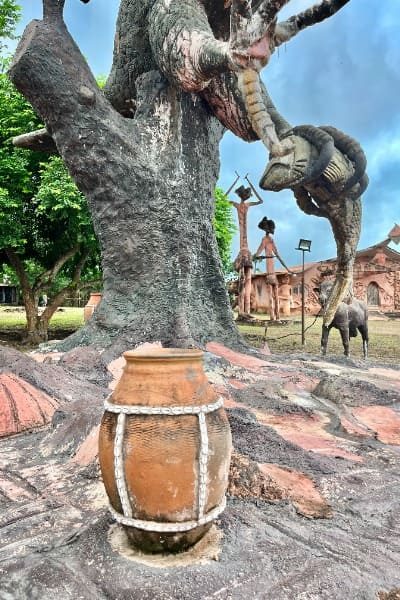
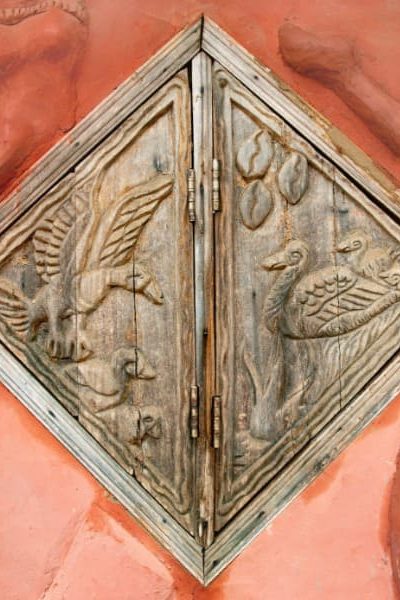
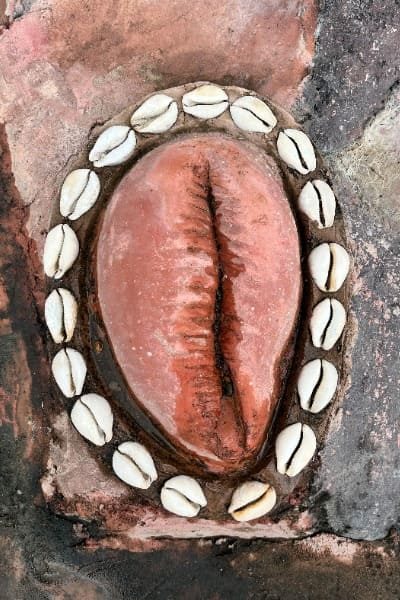
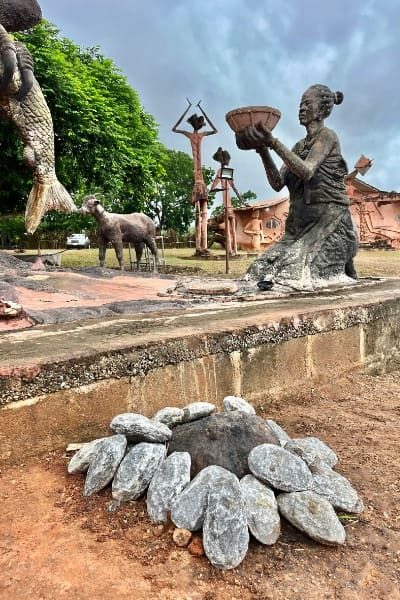
The warrior from the city of Ẹdẹ located in the Nigerian state of Ọ̀ṣun is also called Aṣíwájú Òrìṣà, the leader of the Òrìṣà. He is the mythological son and pupil of Òṣọ́ọ̀sí and an avid hunter possessing extraordinary strategic abilities. He has a strong intuition, sharp perception, and tremendous courage. He is a poet and protector of the humiliated and those who have been falsely accused. He is being worshiped in order to attract agility, prosperity, affluence, and well-being. He brings luck in business and finance.
Metals that belong to him are gold, yellow brass, and copper. His symbols are óta (an altar stone), ìrùkẹ̀rẹ̀ (an artistically processed animal tail that is infused with magic and worn by priests and priestesses, kings and queens to showcase their royal dignity), cowries, and ọfà (a spear and a sword made of golden plated metal). His colours are yellow and blue. His necklaces and bracelets are made of yellow and blue beads.
This divinity was brought to Abéokúta, the capital of the Ògún State, by Saaba people, specifically by a female slave. Nana is extremely powerful because she is a daughter of the Supreme God and as such, she is also referred to as Omolú, which is an expression composed of two words: ọmọ, a child, and olúwa, a god, meaning that the expression denotes a God’s daughter. Among the people of Ewe and Ẹ̀gbá, Nana Bùrúkù represents an androgynous being. The Yoruba refer to the male principle as Bùrúkù while the female principle is called Omolú. This divinity demands strict discipline and is worshiped in order to avoid poverty, misery, distress, and to gain power. The symbols of the Òrìṣà Omolú are ẹdon (a statue of a male and female couple made of metal), ibiri, an object that Nana caries in her right hand that symbolizes the sequence of generations, carved wooden statues of different sizes that depict people, divinities, pregnant women, or women carrying a baby on their backs. Breastfeeding mothers are also to be found. Furthermore, her symbols also include óta (an altar stone), ìrùkẹ̀rẹ̀ (an animal tail with artistic decoration that is infused with magic and worn by priests and priestesses, kings and queens as a sign of their royal dignity), and cowries.

The Òrìṣà Ọbà is calm, compliant, tolerant, devoted, good-hearted, magnanimous, and motherly. She is closely associated with Ìyá-mi Òṣòròngà and devoted to the principles of female aesthetics.
Metals that belong to her are gold and iron. Her symbols include rivers, vessels, óta (an altar stone), ìrùkẹ̀rẹ̀ (an artistically processed animal tail that is infused with magic and worn by priests and priestesses, kings and queens to showcase their royal dignity), and cowries. Her colour is white, though she is often depicted with multi-coloured items. Her necklaces are embellished with beads in a variety of different colours as well as golden or metal bracelets in shades of gold, such as brass.
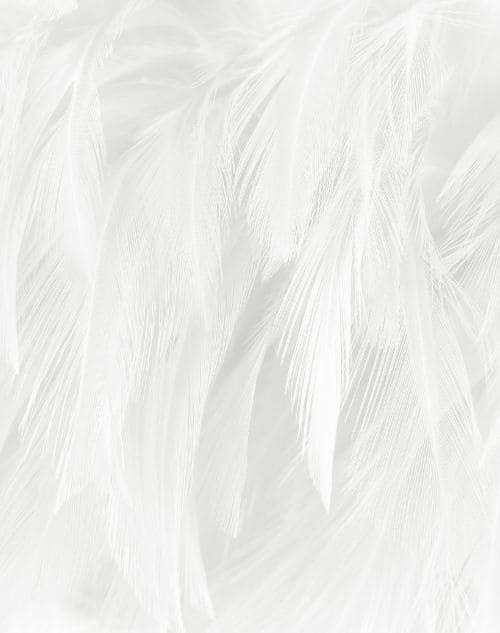
The Supreme god Elédùnmarè instructed the Òrìṣà Ọbàtálá to create the solid ground, to inhabit it, and to shape the physical form of humans. This is why he is often described as the representative of Elédùnmarè on Earth. He is the Òrìṣàof creativity, peace, and tranquillity who neutralizes turbulences and transforms his devotees so that they become successful as long as they do their best. Ọbàtálá gives his children a reason for laughter. With regard to moral values, Ọbàtálá has high expectations of his devotees because they need to be as pure as spring water.
Metals associated with the Òrìṣà Ọbàtálá are lead and silver. His symbols are ẹfun (blessed natural chalks possessing great powers), ivory, ojé (lead), àjà or àdíjà (a special bell), a white calabash, ọ̀pa ọṣoro (a scepter), ikódíde (a red feather of a bird called odidẹrẹ́), a statue made of wood or ivory that personifies Ọbàtálá, óta (an altar stone), ìrùkẹ̀rẹ̀ (an animal tail with artistic decoration that is infused with magic and worn by priests and priestesses, kings and queens as a sign of their royal dignity), and cowries. The colour that is typical of Ọbàtálá is white. He is depicted mostly as an old man wearing white clothing and white jewellery. All other objects related to him are white as well, including clothing and jewellery of his priests, priestesses, and devotees. His necklaces are made of white or ivory beads. The Òrìṣà Ọbàtálá is being worshiped throughout the entire Yoruba territory.
The name of the Òrìṣà Ọbalúwayé stems from the shortened version of the expression Ọba-‘lu’-aiyé, which means “the King that rules the Earth”. He is related to healing, justice, and social peace. His energy is manipulated with the intention of expressing gratitude to the Earth for everything it offers to people. His power is being used for healing any kind of diseases, especially the most severe ones and those related to skin.
The symbols of the Òrìṣà Ọbalúwayé are óta (an altar stone), ìrùkẹ̀rẹ̀ (an animal tail with artistic decoration that is infused with magic and worn by priests and priestesses, kings and queens as a sign of their royal dignity), cowries, ẹ̀jùwẹ̀rẹ̀ (a ritualistic instrument similar to ìrùkẹ̀rẹ̀ that is made of leather and sometimes decorated with beads or pearls), clay, yangí (a volcanic stone, laterite, the symbol of Èṣù), and agbada (a clay pot with a wide opening). His colours are white, black, and red. Typical pieces of Ọbalúwayé’s jewellery include lágídígbà (a necklace made of black beads), a palm tree nut shells or a buffalo horn, and a necklace made of interchanging white and black beads.

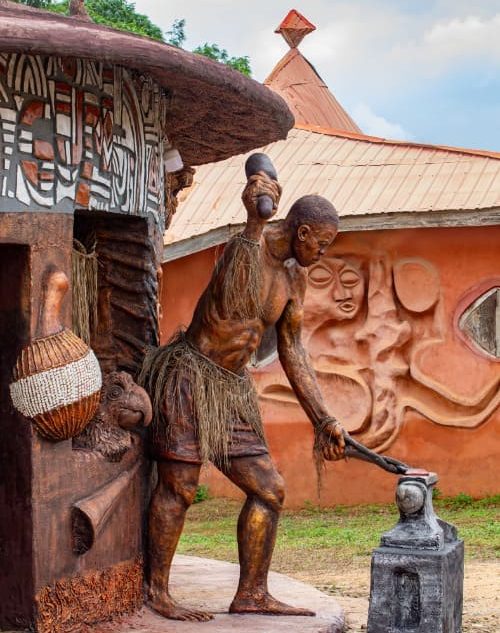
The Òrìṣà Ògún is the divinity of iron, war, and hunting and a patron of blacksmiths, hunters, warriors, and all who manipulate iron, steel, and other metals, including professionals who deal with cutting marcations and circumcision, such as policemen and surgeons. Ògún also protects people and gives them sense for self-defense.
The Supreme god Elédùnmarè chose him to pave the way for civilization. Thanks to his strength and might he personify a hero of civilization: he manipulates the nature of iron and fire. He also presides over mining, metallurgy, and agriculture. This is why he is closely connected with the field of technology. The Òrìṣà Ògún is the pioneer who paves the way towards realization. This is the reason why he is closely connected to the Òrìṣà Ìyá-mi Òṣòròngà.
Ores that belong to him are iron, copper, coal, and all forged metal objects. His symbols are óta (an altar stone), ìrùkẹ̀rẹ̀ (an animal tail with artistic decoration that is infused with magic and worn by priests and priestesses, kings and queens as a sign of their royal dignity), cowries, a tusk or a tail of an elephant, àdá (a long single-bladed knife that resembles a machete), ọ̀bẹ (a knife), aké (a wood carving knife or an axe), ọkọ́ (a hoe or a stirrup), ìyòṣó (a hammer), agogo (a bell), ẹ̀mú (pliers), ọmọ owú (an iron anvil), akokoro (a sickle), ògbó (an iron stick used in forgery), gbénàgbẹ́nà (an instrument used to cut down trees), màrìwò (a palm tree leaf, a piece of clothing that Ògún was wearing when he came from ọ̀run to ayé), pèrègún (Dracaena Fragrans), ìbọn (a shotgun), and other iron objects. His clothing and necklaces are in strong shades of blue.
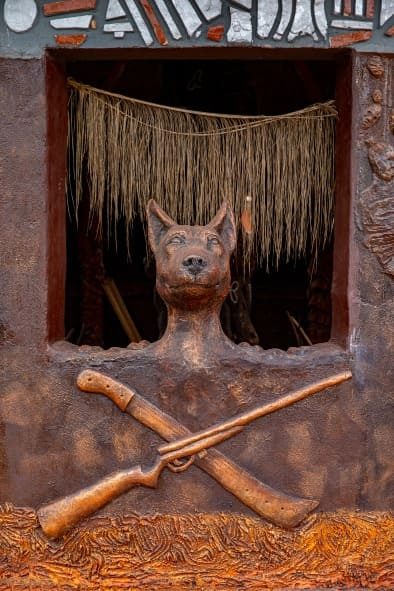
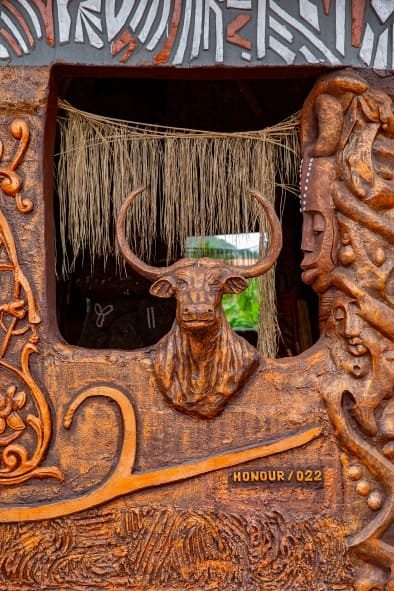
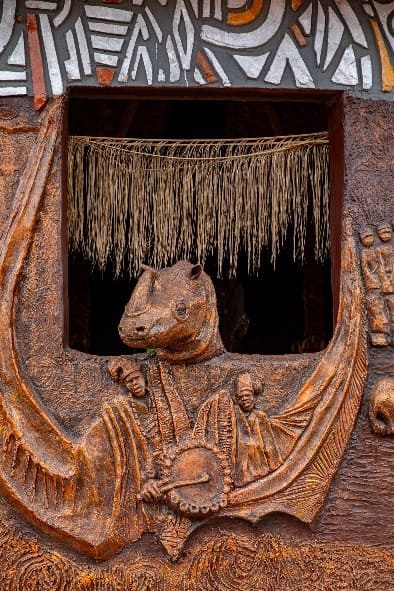
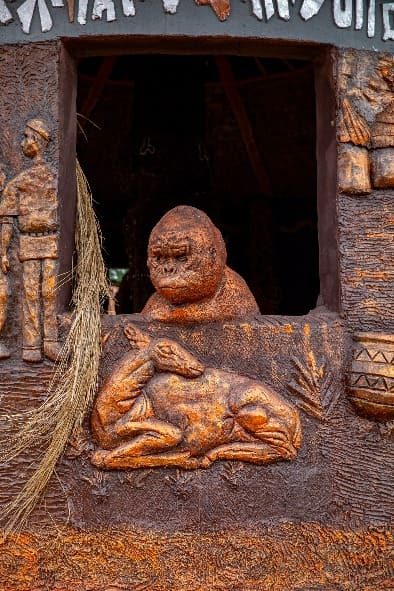
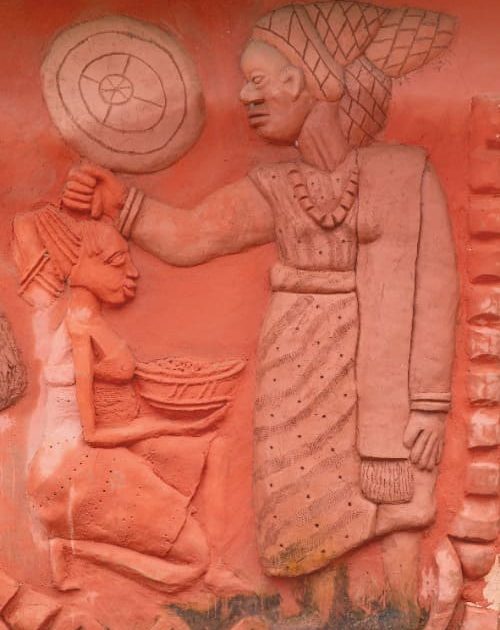
Orí, the royal essence of beings, is a personal divinity that leads, directs, and helps humans from the moment of birth, throughout the entirety of their lives and after death as well. The literal meaning of the word Orí is the head in the physical sense, which is the highest symbol of Orí inú, the inner head. The divinity is also called Oríṣé, meaning “The origin of all the Òrìṣà”. As a partially independent entity on his own, Orí is regarded as a divinity that is worshiped the same way as any other; he receives offerings and prayers are addressed to him. People whose Orí inú is in a good position find themselves in favourable situations.
The symbols of Orí are the head, óta (an altar stone), ìrùkẹ̀rẹ̀ (artistically processed animal tail that is infused with magic and worn by priests and priestesses, kings and queens to showcase their royal dignity), and cowries.

In Africa hunters are regarded as soldiers. Ògún’s first students in the art of hunting and war were Òṣọ́ọ̀sí and Erinlẹ̀. He is immersed in hunting and possesses keen strategic skills, sharp intuition, and heightened sensing abilities. Besides hunting animals, his hunting-related activities include all kinds of conquests or achievements in the field of professional development and economics. He loves the forest and knows each and every being residing there. He highly respects and enjoys outdoor living and music. The latter is often used in hunting and military activities with the aim of attracting good luck and turning any kind of work into a source of pleasure. He is the protector of the humiliated and of those who experience injustice. He is being worshiped with the intention of attracting agility and swiftness; he brings luck in business and in any other activity related to money. He also takes care of family affairs.
His metal is iron. His symbols are óta (an altar stone), ìrùkẹ̀rẹ̀ (an artistically processed animal tail infused with magic that is worn by priests and priestesses, kings and queens to showcase their royal dignity), cowries, ẹfun (blessed natural chalks that possess great powers), and osùn (a type of red pigment that is used for ritualistic purposes). The colour of the Òrìṣà Òṣọ́ọ̀sí is blue, the same shade as for Ògún. His beads are either exclusively blue or used interchangeably with white beads, with or without cowries. His bracelets are made of leather and may also be decorated with cowries.
The Òrìṣà Ọ̀ṣun is the goddess of rivers, precious metals, fertility, prosperity, sensuality, sexuality, and love. Alternatively referred to as “The mother of all children”, she strives hard to improve fertility and secure prosperity and well-being of men and women. She offers protection from any unfavourable event and is invoked in many different circumstances because she is always able to provide help.
The symbols of the Òrìṣà Ọ̀ṣun are ankle bracelets, bracelets, various objects made of copper, gold, brass and other golden plated metals, a sword, a fan, a comb, and a mirror. Her other symbols include óta (an altar stone), ìrùkẹ̀rẹ̀ (an animal tail with artistic decoration that is infused with magic and worn by priests and priestesses, kings and queens as a sign of their royal dignity), cowries, coins, pèrègún, osùn (a type of red pigment used for ritualistic purposes), white linen, and statues depicting a woman with braided hair holding a child in her hands or breastfeeding it. The colour that is typical of the Òrìṣà Ọ̀ṣun is yellow. Her necklaces are embellished with transparent beads in shades of amber and yellow gold as well as light yellow and ivory.

Invaluable in everyday life and in the cult of Òrìṣà, plants are used as liturgical, magical, and healing medium. The ÒrìṣàỌ̀sányìn, the keeper of Àṣẹ of the plants and their protector, possesses the power to sustain the Àṣẹ of the vegetal world and enables the power of plants to function efficiently. Thus, he needs to be invoked every time the plants are being collected, cropped, or harvested. The Òrìṣà Ọ̀sányìn is a marvellous healer when it comes to the elimination of difficulties and the alleviation of suffering. People initiated in Ọ̀sányìn receive the power to manipulate plants. Anyone who deals with the kingdom of plants, even if not initiated, is always closely connected to this Òrìṣà.
The basic symbols of the Òrìṣà Ọ̀sányìn are ọ̀pa (a forged metal stick with sixteen birds), ṣẹ̀kẹrẹ (a kind of a rattle), and àdó (a small hollowed and dried calabash for storing the powder that is used for healing and magical purposes).

The Òrìṣà Ọya is a lithe, lissom, and swift Òrìṣà; the goddess of winds and storms. She is the partner of Ṣàngó, the master of thunder and lightning, and expresses her dissatisfaction through strong winds and storms. She enables her devotees to live their lives at the right speed. She is the Òrìṣà of fidelity and courage.
Her symbols include swords, buffalo horns, stones from the river Ọya, clay pots, óta (an altar stone), ìrùkẹ̀rẹ̀ (an artistically processed animal tail that is infused with magic and worn by priests and kings to showcase their royal dignity), and cowries. Her necklaces are embellished with beads in brown shades.
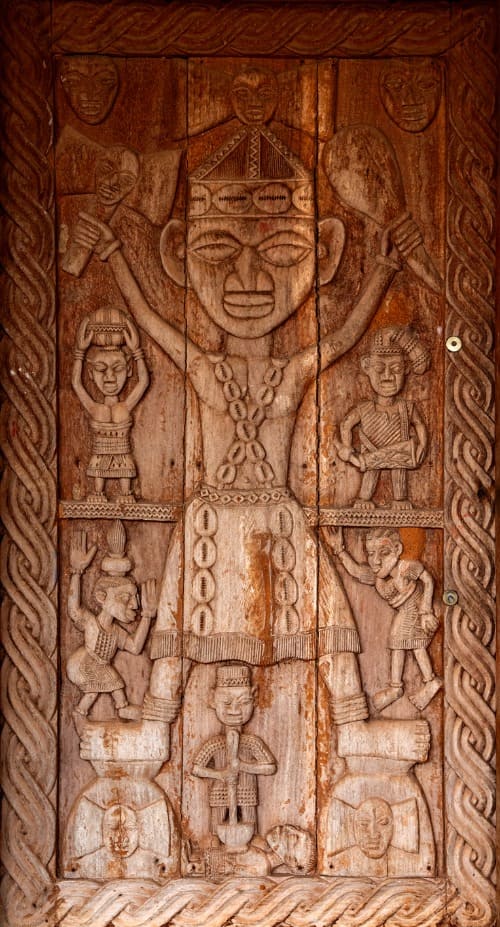
In nature, the Òrìṣà Ṣàngó is the Master of lightning and thunder; and amongst people, he is the Master of justice. He is wild but good-hearted; the one who takes care of children, provides money, and facilitates healing; he is the bearer of justice because he thoroughly despises deception, lies, and stealing. He is being equated with the Òrìṣà Jàkutá, the one who destroys with stones, the original divinity of thunder and lightning.
The symbols of the Òrìṣà Ṣàngó are a sink-shaped pot containing ordinary axes and axes made of stone called ẹdùn àráthat are used for punishment; ìrùkẹ̀rẹ̀ (an animal tail with artistic decoration that is infused with magic and worn by priests and priestesses, kings and queens as a sign of their royal dignity); and cowries. His clothing and necklaces are red and white.
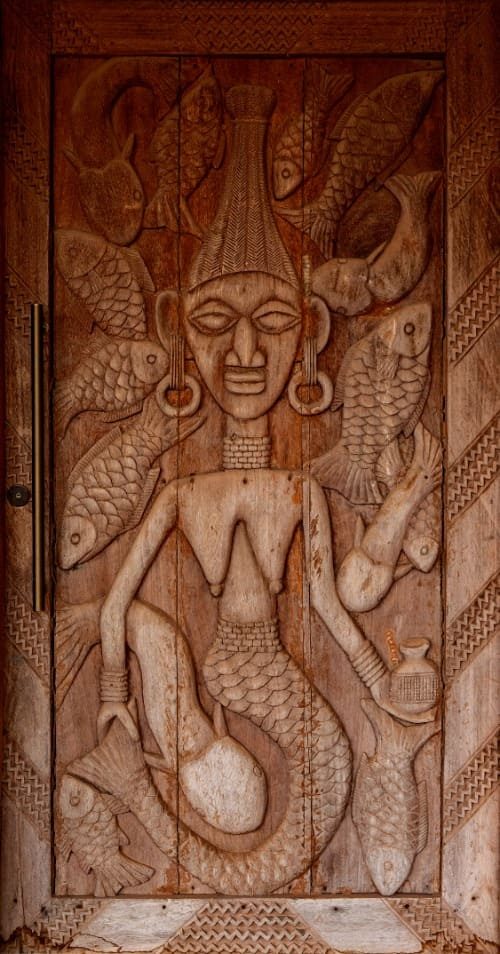
The Òrìṣà Yemọja, the goddess of all waters, is related to fertility and the process of giving birth. She blesses her devotees with fertility, longevity, well-being, prosperity, success, and patience while inspiring them to fight for their life.
The metal that belongs to the Òrìṣà Yemọja is silver. Her symbols also include the sea, vessels, corals, seashells and starfish, sea fossils, óta (an altar stone), ìrùkẹ̀rẹ̀ (an animal tail with artistic decoration that is infused with magic and worn by priests and priestesses, kings and queens as a sign of their royal dignity), and cowries. Her colours are white and all shades of blue. Her necklaces are made of transparent white beads and beads in different shades of blue.